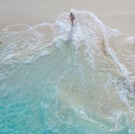A crisp spring wind whipped over the River Test, skimming the water that flowed on its path to the Solent. From my open-air viewpoint metres above water, the sunless sky is punctured by one thing only: the hulking red and black funnel that have crowned Cunard ships for almost two centuries.
On Tuesday evening, Southampton welcomed Queen Anne, the latest monarch to join Cunard’s fleet. There was much fanfare in the south-coast city, with crowds watching her sail in through the arcs of a water salute, Cunard’s first female captain, Inger Klein Thorhauge, at the helm. The following day, I was among the first to step onto her decks as she docked at her homeport, where the line’s ships have been based since 1919. In a swell of container ships and the concrete jungle of the port, Queen Anne beamed as a diamond in the rough.
Even the most reluctant of cruisers should appreciate Cunard Line; it’s a brand that transcends the industry and peppers history books. Since its first transatlantic crossing in 1840, its ships have been considered the height of luxury at sea – its designs drawing comparisons to The Ritz hotel at the end of the 19th century. Names, from Charles Dickens and Mark Twain to Judy Garland and David Bowie, have sailed under those famed funnels. Cunard’s Carpathia steamed to the stricken Titanic to rescue survivors in 1912.
Jumping forward to October 2019, I was at the Fincantieri shipyard in Castellammare di Stabia, southern Italy, to watch the steel-cutting ceremony – the cruise equivalent of a ground-breaking celebration – for an unnamed ship that would become Queen Anne. Built at a reported cost of £500 million, it’s the company’s first new vessel in 14 years (sailing two years later than planned).
Read more on Europe travel:
And while the 3,000-capacity Queen Anne (plus space for 1,200 crew members) is the 249th ship to sail under Cunard’s flag, what makes this such a milestone is her joining the coveted ranks of Cunard’s ‘queens’, which themselves hold a special place in cruise culture, as well as British consciousness.
She expands the current trio – Queen Mary 2, Queen Elizabeth, Queen Victoria – into a quartet, and is an echo of its regal predecessors. Two are now decommissioned and sit as floating hotels (Queen Elizabeth…
Click Here to Read the Full Original Article at The Independent Travel…
